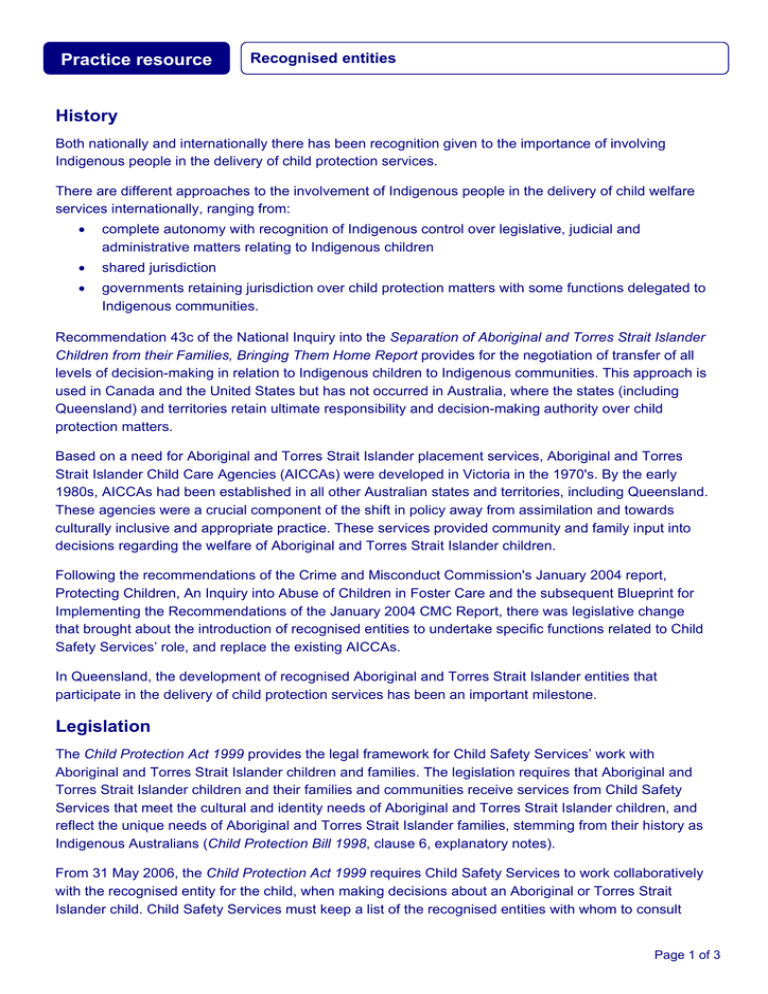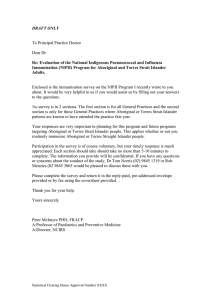Practice resource: Recognised entities (Child Safety Practice Manual)
advertisement

Practice resource Recognised entities History Both nationally and internationally there has been recognition given to the importance of involving Indigenous people in the delivery of child protection services. There are different approaches to the involvement of Indigenous people in the delivery of child welfare services internationally, ranging from: • complete autonomy with recognition of Indigenous control over legislative, judicial and administrative matters relating to Indigenous children • shared jurisdiction • governments retaining jurisdiction over child protection matters with some functions delegated to Indigenous communities. Recommendation 43c of the National Inquiry into the Separation of Aboriginal and Torres Strait Islander Children from their Families, Bringing Them Home Report provides for the negotiation of transfer of all levels of decision-making in relation to Indigenous children to Indigenous communities. This approach is used in Canada and the United States but has not occurred in Australia, where the states (including Queensland) and territories retain ultimate responsibility and decision-making authority over child protection matters. Based on a need for Aboriginal and Torres Strait Islander placement services, Aboriginal and Torres Strait Islander Child Care Agencies (AICCAs) were developed in Victoria in the 1970's. By the early 1980s, AICCAs had been established in all other Australian states and territories, including Queensland. These agencies were a crucial component of the shift in policy away from assimilation and towards culturally inclusive and appropriate practice. These services provided community and family input into decisions regarding the welfare of Aboriginal and Torres Strait Islander children. Following the recommendations of the Crime and Misconduct Commission's January 2004 report, Protecting Children, An Inquiry into Abuse of Children in Foster Care and the subsequent Blueprint for Implementing the Recommendations of the January 2004 CMC Report, there was legislative change that brought about the introduction of recognised entities to undertake specific functions related to Child Safety Services’ role, and replace the existing AICCAs. In Queensland, the development of recognised Aboriginal and Torres Strait Islander entities that participate in the delivery of child protection services has been an important milestone. Legislation The Child Protection Act 1999 provides the legal framework for Child Safety Services’ work with Aboriginal and Torres Strait Islander children and families. The legislation requires that Aboriginal and Torres Strait Islander children and their families and communities receive services from Child Safety Services that meet the cultural and identity needs of Aboriginal and Torres Strait Islander children, and reflect the unique needs of Aboriginal and Torres Strait Islander families, stemming from their history as Indigenous Australians (Child Protection Bill 1998, clause 6, explanatory notes). From 31 May 2006, the Child Protection Act 1999 requires Child Safety Services to work collaboratively with the recognised entity for the child, when making decisions about an Aboriginal or Torres Strait Islander child. Child Safety Services must keep a list of the recognised entities with whom to consult Page 1 of 3 Practice resource Recognised entities about the protection and care of Aboriginal or Torres Strait Islander children (Child Protection Act 1999, section 246I). A recognised entity may be an individual or organisation that is appropriate to be consulted about the child's protection and care under an agreement between Child Safety Services and the entity. If the entity is an individual, he or she must: • be an Aboriginal or Torres Strait Islander person • have appropriate knowledge of or expertise in child protection • not be an officer or employee of Child Safety Services. If the recognised entity is an organisation, its members must include Aboriginal or Torres Strait Islander persons who have appropriate knowledge of or expertise in child protection and are not officers or employees of Child Safety Services. It must also provide services to Aboriginal persons or Torres Strait Islanders (Child Protection Act 1999, section 246I). In accordance with the Child Protection Act 1999, section 6(1) and (2), when Child Safety Services makes decisions about an Aboriginal and Torres Strait Islander child, it is required to either: • provide the recognised entity with an opportunity to participate in the decision-making, where the decision is significant • consult with the recognised entity on all other decisions. Role and functions In order to achieve a reduction of the over-representation of Aboriginal and Torres Strait Islander in the child protection system, all stakeholders need to be actively engaged in responding to and developing a strong continuum of care for Aboriginal and Torres Strait Islander children. Child Safety Services recognises the right of Aboriginal and Torres Strait Islander people to participate fully in all levels of decision-making about Child Safety Services’ intervention and works in partnership with recognised entities to: • address the over representation of Aboriginal and Torres Strait Islander children in the statutory child protection system; and • ensure that Aboriginal and Torres Strait Islander children who enter the statutory system receive the best available service. Child Safety Services funds community based organisations to undertake the role and functions of a recognised entity. Individuals may play this role, when there is no community organisation to take on the role. Each CSSC is responsible for developing protocols to guide their joint work with the local recognised Aboriginal and Torres Strait Islander entity. Recognised entities undertake two key functions in providing Child Safety Services with cultural and family advice and promoting the best interests of Aboriginal and Torres Strait Islander children: • to be involved in decisions about Aboriginal and Torres Strait Islander children made by Child Safety Services Page 2 of 3 Practice resource • Recognised entities to support and provide information to Aboriginal and Torres Strait Islander families to help them understand the purpose and impact of the statutory child protection process. To effectively undertake these functions, the recognised entity works closely with, and has strong links to, its community, family and clan groups. Page 3 of 3




